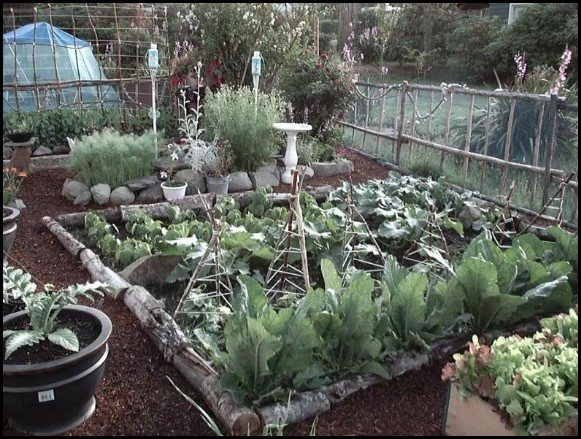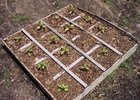Raised Bed Gardening for Growing Vegetables without Digging
RAISED BED GARDENING - Materials for Building Raised Beds
When planning for raised bed gardening your raised beds can be built out of any suitable material that will give you the desired depth. For most vegetables, you won't need anything more than 6 inches in depth. You can use house bricks, concrete blocks, sleepers, treated pine logs, shutter board or even discarded, hard plastic paddling pools, old sinks or even a cut down corrugated water tank. There are also options where you can buy purpose built corrugated raised beds and wooden raised beds from gardening shops and outlets which are more expensive.
Another option in raised bed gardening is to outline to bed in large rocks and fill the center with soil. When the soil has reached the top of the rocks, then add another layer of rocks and fill the soil in to the top of the second layer of rocks. Make sure that the second row of rocks is placed just a little way in from your foundation level so as to minimize soil erosion when it rains, especially when the beds are still new and the plants haven't taken root yet.
RAISED BED GARDENING - Dimensions for your Raised Beds
As mentioned before, a raised bed built to a depth of 30cm is more than enough for root crops, including carrots and parsnips. For leaf crops you can get away with 15 cm. Your raised bed garden can also be built to waist height for those people who not only find it difficult to dig, but also find it difficult to bend.
The width of the raised bed will be determined by what is comfortable for you, as periodically, you will have to get in there to weed and harvest your crops. 120cm in width, or 4 feet, as long as you can access it from both sides, is ideal. If you can only access it from one side, then shorten it to that of an arm's length. The length of the bed is up to you.
The spaces left between the beds is comfortable at 45cm unless you need to push a wheelbarrow between the beds, then you will have to double it. But if you can, leave the space at 45cm, and find an alternative route for the barrow.

RAISED BED GARDENING - Soil Preparation
If your manure is fresh, wait 2-4 weeks before planting as the manure will burn the roots of your seedlings. Chicken manure is the best manure for growing vegetables because of its high nitrogen content. The only raised garden bed that you will want to use the poultry manure sparingly will be for root crops, especially carrots as too much manure will make the carrots split.
RAISED BED GARDENING - Crop Spacing
If your manure is fresh, wait 2-4 weeks before planting as the manure will burn the roots of your seedlings. Chicken manure is the best manure for growing vegetables because of its high nitrogen content. The only raised garden bed that you will want to use the poultry manure sparingly will be for root crops, especially carrots as too much manure will make the carrots split.
At 100mm spacings, on the other hand, individual bulbs will be a lot smaller, but total yields will be higher. Smaller bulbs will store for longer periods and are often more useful.
However, spacings between plants in raised bed gardening has to be practical. If large spaces are allowed the vegetables will never fill those spaces and this will be a waste of space. If planted too close together the plants will choke each other, and there will be little of the vegetable that is big enough to eat.
RAISED BED GARDENING - Sowing and Planting Guide for Intensive Beds
BROAD BEANS (tall) 150-225 mm
BROAD BEANS (dwarf) 225-300 mm
BEANS (bush) 225-300 mm
BEETROOT 75-100 mm
Brussels SPROUTS 500-700 mm
CABBAGE (small) 250 mm
CABBAGE (large) 450-600 mm
CAULIFLOWER (small) 250 mm
CAULIFLOWER (large) 450-600 mm
CARROT 75-100 mm
CELERY 250 mm
CUCUMBER 600 mm
LEEK 75-225 mm
LETTUCE 225 mm
ONION (spring) 25 mm
ONION (keeping) 100-150 mm
PARSNIPS 75-150 mm
PEAS 75-100 mm
POTATOES (early) 225 mm
POTATOES (main crop) 300 mm
CORN 375 mm
TOMATOES (staked) 600 mm
TOMATOES (bush) 450 mm
For vegetables that are widely spaced inter-crop with fast growing vegetables such as radishes, spring onions, rocket and some lettuces. Check our page on companion planting to see which crops can be grown together. Early potatoes grown between rows of raspberries for example are not an ideal marriage.
RAISED BED GARDENING - Crop Rotation
The object of crop rotation is to avoid certain soil-borne diseases caused be eel worm, or fungus such as club-foot of brassicas. It also makes good use of organic fertilizers.
For example, a fertilizer of well-rotted poultry manure is high in nitrogen and ideal for leaf crops such as cabbage, lettuce etc. When followed by root crops, the remaining mineral salts should be adequate to grow healthy carrots, parsnips etc. Hence the light feeders such as roots, bulbs, legumes, tubers and small lettuces can follow call other crops which are classed as heavy feeders. See our page on growing carrots for in depth instructions and advice.
Knowing which vegetables belong to which family is important, because diseases are common to each member of the same family.
| GROUP ONE: | GROUP TWO: | GROUP THREE: | GROUP FOUR: | GROUP FIVE: | GROUP SIX: | GROUP SEVEN: |
|
Capsicum Eggplant |
Onion Leek |
Pumpkin Marrow Melon |
Cabbage Cauliflower Brussels Sprouts Swede Radish Mustard Kohlrabi |
Silver Beet Swiss Chard Red Beet |
Peas Beans Lupin Clover Lucerne Legumes |
Parsnip Parsley |
Legumes (Group Six) may not thrive when grown directly in the soil after alliums (Group Two) due to under composed root exudation. Legumes are unique in that they return to the soil more nitrogen that they use during their growth, however, edible crops are not good sources compared with clover and lucerne.
As you can see, as long as you have soil, drainage and suitable containers or boxes built out of handy material, you can build raised beds very successfully. Raised bed gardening is an ideal way of raising healthy vegetables without heavy digging or bending. If you want to take raised bed gardening even further, have a look at how you can grow more vegetables in less space, with less weeding and effort using the square foot gardening method.
Buy Raised Bed Garden Kits
Click on each of the pictures to give you prices and details.Books and Boxes for Raised Bed Gardening
You can Add your own Comments, Tips and Ideas on Raise Bed Gardening Here!
We have lots of pages where you can contribute to throughout this website. We love hearing from our readers, and hope you will be one of those we hear from too. Look around our homesteading website. If you have some comments, tips and ideas about raised bed gardening of your own, please submit them. All you need to do is type and submit. We will do the rest!
Leave a Comment
Do you have anything that you would like to add after reading this page? We would love to hear your thoughts. If you can add additional information to what has been written here you will be adding value to the website! No need to have any special skills - just type and submit. We will do the rest!
Follow Us: Facebook, Twitter, Google+, Pinterest, RSS
 |
 |
 |









New! Comments
Do you have something of value to add? Leave me a comment in the box below.